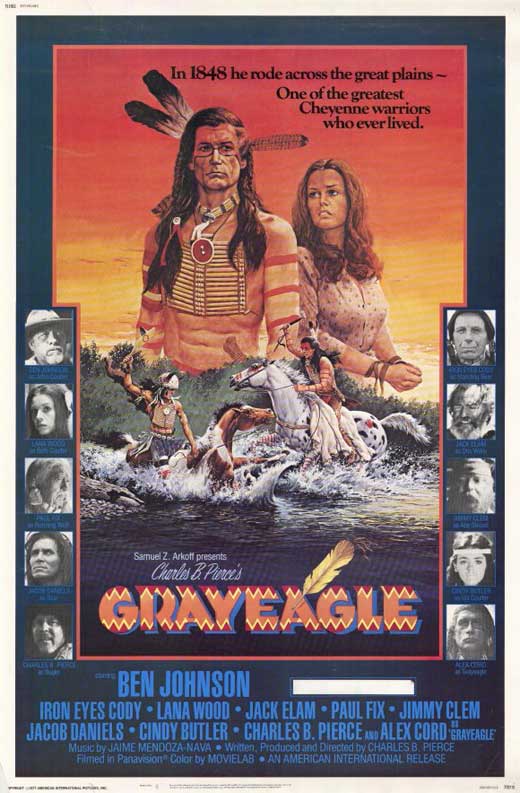
During the last portion of the 20th Century, filmmakers became slightly attracted to the notion of making moving pictures about Native Americans — or, as Mel Brooks would delicately describe them in his spoof of the cowboy picture genre, Blazing Saddles: “those little red devils.” Indeed, American Indians had long been present on film since the earliest B-Western first appeared on matinee screens more towards the beginning of the 1900s, though they were almost always portrayed in a negative light; barbaric, scalping fiends brought to life by the most non-native-looking white men possessing the largest noses that Hollywood schmucks could hire for a handful of beans.
As the ’70s rolled through, however, America was suddenly informed that the Indian folk weren’t all that bad after all — and the mostly-inaccurate stories of evil redskins that had been passed down from generation to generation were usually just poor translations of an indigenous peoples attempts to reclaim what whitey had unfairly taken from them. So, the beginning of the “nice,” non-scalp-crazy Native American stories hit the screen — primarily in the western and drama genres — fables that, despite having little to no basis in fact (not to mention reality) whatsoever, tended to star white guys with big noses in the leads.
Around the same time, a popular public service announcement to “Keep America Beautiful” depicted an Indian crying over pollution. It was an iconic announcement that featured phony Native American Iron Eyes Cody — who was really Italian (!) — as the canoeing big-nosed lad with a feather sticking out of his headband.
Well, at least they tried, right?
[The sigh.]
Since I’m on the subject of people trying to make movies and Iron Eyes Cody, now is as good of a time as any to mention the entire purpose of this article: Grayeagle. And a mention is about all this flick deserves, too, as it’s basically little more than a low-budgeted frontier adventure made to look like a big-budgeted spectacle. The only notable merits of said film rise from such minor details as the screenwriter/producer/director of this forgettable uncredited remake of The Searchers was none other than Charles B. Pierce. If the name means nothing to you, then you are no doubt not an avid follower of the cult movies of the 1970s which tend to hail from the South.
Pierce was a feller who made a small mint with the sasquatch-themed The Legend of Boggy Creek in the early ’70s. The Legend of Boggy Creek became a hit on the drive-in circuit, spawning two sequels (one of which is unrelated while the other wound up on Mystery Science Theater 3000) as well as opening the door for several dozen more Bigfoot and “mysterious critters” features for years to come. He would also donate two more titles to the annals of horror history — The Town That Dreaded Sundown and The Evictors — and also wrote the screenplay for the Clint Eastwood/Dirty Harry entry, Sudden Impact.
When he wasn’t busy making or contributing cult classics like the aforementioned movies, however, Pierce brought several other stories to life on the big screen that focused on Native Americans, one of which is Grayeagle.
I suppose I had better say something about the film, so here goes…
A Cheyenne warrior named Grayeagle — who is laughably portrayed by paleface Alex Cord — kidnaps Beth (Lana Wood, the less-talented sister of Natalie), the grown daughter of settler John Colter (Ben Johnson, looking more like Arch Hall, Sr. than ever before). With the help of his trusty Indian pal Standing Bear (Iron Eyes Cody — brought in, no doubt, to give the project that “authentic” Native American feel to it!), John then starts to roam the wilderness, calling on the great spirit of Jack Elam (played, coincidentally enough, by Jack Elam) to assist. They eventually succeed, though they lose their audience and any credibility they may have once had in the process. The end.
Grayeagle also features Paul Fix (Marshal Torrance in The Rifleman) as an elder Indian. Mr. Chuck Pierce himself delivers one of the film’s most over-the-top performances as a bugler who has been “touched by the great spirit” (he’s a loon), while lots of Anglo-Saxons (and maybe a Mexican or two) bring every Indian stereotype to life. Boggy Creek II’s own Jimmy Clem also appears as a storekeeper.
While the movie itself isn’t one that will stand prominently on my wall of movies next to say, my prized Beta copy of Breakin’ 2: Electric Boogaloo, we can at least take comfort in the fact that MGM has actually brought this chapter of Charles B. Pierce’s cinematic legacy to DVD-R as part of its Manufactured-On-Demand “Limited Edition Collection.” The movie is presented in anamorphic 2.35:1 widescreen, giving us a chance to see some of the famous Big Sky country that Montana always boasts (there is some nice scenery here every once in a while, I will give it that) as Pierce originally intended for us to see; the title was previously only available via a dated pan-and-scan videocassette release which I recently found in the backroom of a bookstore.
And, even though I’m not a fan of this movie, I have to say MGM’s Limited Edition release blows that old crappy VHS out of the water (so I’ll give it that, too).
Best recommended for curiosity seekers, you hardcore fans of Pierce out there (you know who you are), and those of us who have a unsuitable tendency to giggle and shake our heads continuously over the sight of Caucasians portraying people of different ethnic backgrounds.